“Do exactly as I tell you. Wear dark clothing. Don’t wear anything white. And wear sturdy shoes you won’t mind getting wet. Don’t wear flip-flops because you’ll lose one or both in the water, and you won’t be able to move to retrieve them.”
Dr. Donna Shaver stressed these specifics to me after granting me and my cameras permission to be within the roped-off sand strip during a public release of Kemp’s ridley sea turtle hatchlings at Padre Island National Seashore in Texas.
Earlier this spring, the Traveler put me in touch with Dr. Shaver, chief of the Division of Sea Turtle Science and Recovery at the national seashore. I was heading south for some beach photography at Padre Island, and although Dr. Shaver was extremely busy with the start of sea turtle nesting season, she took time from her full schedule to answer some questions about what she does and about Kemp’s ridley sea turtles, in general.
Note: This article focuses on the Kemp’s ridley sea turtle, with material derived from my interview with Dr. Shaver and information taken from Padre Island National Seashore’s website.
Padre Island National Seashore is the only place in Texas where nests of five federally listed threatened or endangered species of sea turtles have been found: Kemp’s ridley, loggerhead, leatherback, green, and hawksbill. The Kemp’s ridley is the most endangered species of sea turtle in the world.

Dr. Donna Shaver preparing for a public hatchling release, Padre Island National Seashore / Rebecca Latson
Because of the fragile nature of the sea turtle populations, Dr. Shaver and her staff have been working for more than 30 years to rescue sea turtle eggs along the Texas coast, incubate them, and release them back to the Gulf of Mexico, while at the same time educating the public about sea turtle conservation and recovery.
Did you know:
- Of the five species of federally threatened or endangered sea turtles, Kemp’s ridley is the smallest in size, measuring (on average) 2 feet in length and weighing in at about 100 pounds.
- While male Kemp’s ridleys spend their entire lives at sea, females return to land approximately every two years to lay their eggs. A group of sea turtle eggs is called a clutch.
- A mass nesting of Kemp’s ridley sea turtles is called an “arribada,” the Spanish word for arrival.
- The eggs look like leathery white golf balls and become more round as they incubate.
- Kemp’s ridley hatchlings measure 1.5–2 inches in length, and their carapace (shell) is almost as wide as it is long. For a frame of reference, these hatchlings are smaller than an action cam; they are about the size of a nacho chip, as one volunteer told me.
- Not all hatchling releases occur during the morning, nor are they all public. Sometimes, during the night, the turtles hatch and go into a “frenzy” where they are extremely active and must be released sooner than the normally scheduled 6:45 a.m. morning public viewing.
- Once a hatchling reaches the water, it will swim/float into sargassum and remain there as it grows, eating little shrimps and other animals within and around the sargassum.
- A Kemp’s ridley turtle’s diet consists mainly of crab, but in the absence of their favorite food, they will also eat other marine invertebrates as well as some plants.
- Padre Island National Seashore volunteers go through two days of turtle school training and are taught how to drive the off-road vehicles (ORVs) that roam along the beach in search of nests and turtles actively nesting.
Below are answers to some questions I asked Dr. Shaver in person and via email, and also took from her 2015 booklet "Kemp's Ridley Sea Turtles - Travelers in the Gulf of Mexico, Padre Island National Seashore."
What is the average number of eggs collected for incubation?
“Each clutch contains on average 97 eggs, but that number can vary. Nests found in Texas north of North Padre Island are brought to our incubation facility at Padre Island National Seashore, where we also incubate eggs from about two-thirds of the nests found at the national seashore (about 80-100 clutches per year). Eggs from about a third of the nests found at the national seashore are incubated in a corral at the southern end of the national seashore (about 30 nests per year). Eggs from South Padre Island and Boca Chica Beach are protected in a corral on South Padre Island (about 30-50 nests per year). Note that the hatchlings for the public releases held here are from the eggs incubated in the incubation facility.”
Why take the eggs from their natural nests in the first place?
"Egg rescue and incubation protects from such things as tidal flooding, vehicles driving along the beach, and predators such as fire ants, rattlesnakes, coyotes, ghost crabs, and humans. Incubation also allows for a protected release to ensure all the hatchlings reach the water safely."
How many eggs successfully hatch?
"Hatching success from both the incubation facility and the corral is about 85 percent."
What is the setup for incubation at the Padre Island National Seashore facility?
"The eggs are placed on a bed of sand within styrofoam containers and covered with more sand. Temperature is vital to the incubation process, with warmer temperatures during the middle third of the incubation time producing more females (about 70 percent, 'as occurs in the population'). These temperatures can’t get too warm, though, because too much heat can be lethal for the eggs. The sand is kept moist, but humidity is not strictly controlled. The incubation room is kept dark all the time in order not to expose the hatchlings to light before they are released. Incubation generally lasts from 48-53 days. Eggs that were laid during cooler temperatures earlier in the season take a little longer to hatch. Also, a larger clutch with more viable eggs will be warmer and hatch more quickly." Dr. Shaver told me that the hatching process takes about 1-4 days, which is why you see a range of dates for possible releases on the nesting season/hatching timetable page on the national seashore’s website.
The incubation room is kept quiet, and human intrusion is strictly controlled. In case of a power outage, there are backup generators to be utilized. The natural heating of the building, however, is fine for a short-term outage, and Dr. Shaver indicated they’d never encountered a problem of this nature in the decades of their work at the national seashore.

Watching the release, Padre Island National Seashore / Rebecca Latson
Why wear dark clothing and not anything white during a release?
Kemp’s ridley hatchlings orient themselves to the brightest point, which happens to be toward the sun and the Gulf of Mexico, with all that sunlight reflecting off the water. Wearing white confuses these babies, and they only have a certain amount of stored energy to expend getting from shore to sea. Heading in the wrong direction depletes that energy source and makes it more difficult for them to safely reach their watery destination.
Why wear sturdy shoes during a hatchling release?
Those of the public standing near the water will eventually feel the wash of the tide as it encroaches inland. Once a hatchling reaches water, the waves might move it close to a person’s feet. It is imperative to remain absolutely still in the water and not move or jump back from a wave, due to the possibility of accidentally stepping on a hatchling. Remember, these guys are a little smaller than a GoPro. Flip-flops are a no-no because losing one might cause the wearer to move and rummage around the water in an effort to retrieve the flip-flop and possibly injuring a hatchling. Bare feet aren’t a good idea, either, because even though the area around the hatchling release has been swept of debris, standing in the water risks stepping on unseen sharp shells or glass as well as hidden sting rays.
During my photo sessions within the taped-off area of the release “runway,” I noticed the staff and volunteers wearing dark boots, “wellies,” or Teva-like sandals securely strapped to the foot and ankle. I wore hiking boots I didn’t mind getting wet with salt water. After returning to my hotel room, I wiped the boots down with a damp cloth. There is also a spot along the boardwalk from beach to visitor center with faucets specifically for wash-downs, and there are wash-down rooms next to the visitor center restrooms.
If they only have a limited supply of energy, why not move the hatchlings closer to the water, rather than make them crawl across the beach?
There are several reasons for making the hatchlings crawl across the beach, one of which is that it allows them to “wake up” after their incubation. The staff also wants to assess the babies to ensure they are fully alert, able to move, and oriented in the direction of the water. If these turtles had hatched from a nest on the beach, they would still have had to make the distance across the sand from nest to water. The time taken during the march to the sea helps the hatchlings imprint to that particular area of the seashore, so they will hopefully return near the same spot when it’s time for them to nest.
Why should the public not wave their arms to try and scare away any seagulls coming near?
Seagulls associate humans with food, since people feed the gulls. Groups of people attract gulls, and arm-waving makes the gulls think someone is going to throw food to them, which is why you shouldn’t feed the sea gulls, really. So, don’t wave your arms if a sea gull swoops overhead. Leave this job to those staff and volunteers standing out in the water, holding those bright orange flags meant to scare the seagulls away from hatchlings floating near the shore.
Is the public allowed to take photos at these releases?
Yes, but please don’t use your flash. Point-and-shoots and cell phones tend to have their flash setting on automatic. Turn it off! That momentary flash of light can confuse the hatchling and deplete its energy reserves as it makes its way toward the flash and not the Gulf.
How many people attend a public release?
Believe it or not, as many as 1,000 people may attend a public release. People even plan their vacations around hatchling release dates. During one of the mornings I photographed a release, 860 attendees were counted.
With so many people surrounding a relatively small area, it’s important to share the space with others so their experience is as enjoyable as yours. Staff members periodically make their way around the viewing area with a hatchling in their hands to give the public an up-close view of what a baby Kemp’s ridley looks like. If you ask politely, they might even take your cell phone or camera and take a close-up photo for you. Again, just make sure the flash is turned off. You might also want to use a telephoto lens (“long lens”) to zoom in on the hatchlings from your position behind the roped-off area.
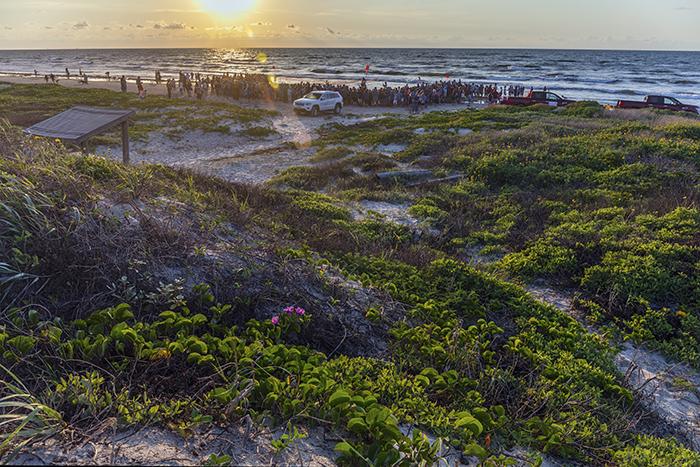
860 attendees on this day's public hatchling release, Padre Island National Seashore / Rebecca Latson
Now that you’ve read about the hatchlings and the incubation/release process, I thought I’d leave you with a series of images to show you, start to finish, a public hatchling release. These images are a combination of photos captured while attending three different mornings of releases.
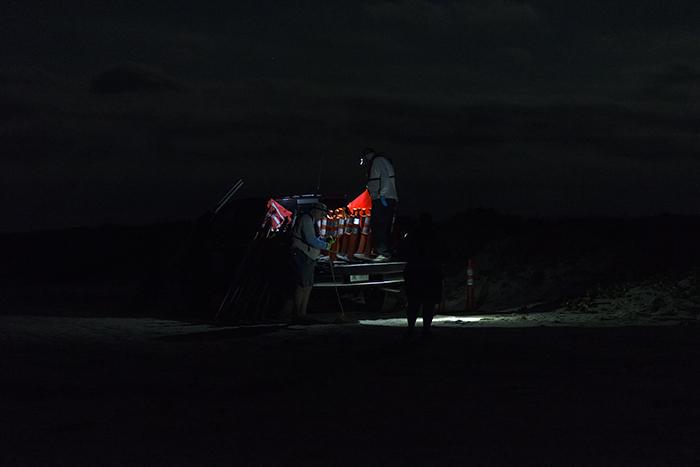
Pre-dawn preparations, Padre Island National Seashore / Rebecca Latson

Raking away the beach debris, Padre Island National Seashore / Rebecca Latson

Unfurling the nets, Padre Island National Seashore / Rebecca Latson

Flagger in the surf, Padre Island National Seashore / Rebecca Latson

An owl to frighten the seagulls, Padre Island National Seashore / Rebecca Latson

Flagger and nets at sunrise, Padre Island National Seashore / Rebecca Latson
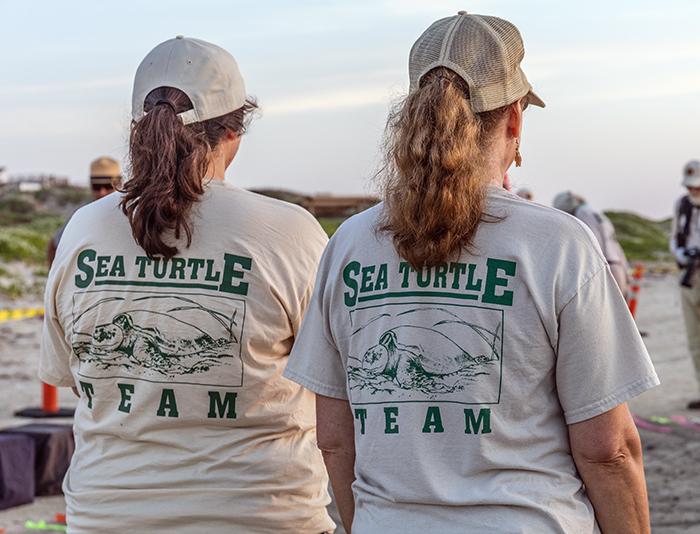
Sea Turtle Team members, Padre Island National Seashore / Rebecca Latson
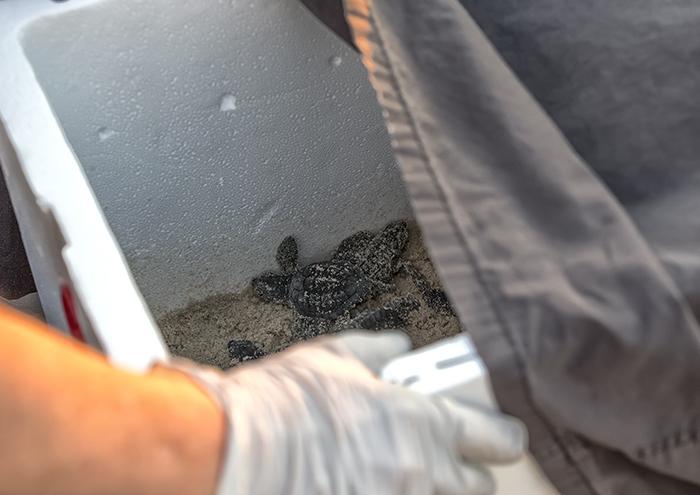
Ready for release, Padre Island National Seashore / Rebecca Latson

Gently releasing each hatchling, Padre Island National Seashore / Rebecca Latson

The first public hatchling release of the year, Padre Island National Seashore / Rebecca Latson

Releasing the hatchlings, Padre Island National Seashore / Rebecca Latson

Kemp's ridley sea turtle hatchlings, Padre Island National Seashore / Rebecca Latson

"Swimming" across the sand, Padre Island National Seashore / Rebecca Latson
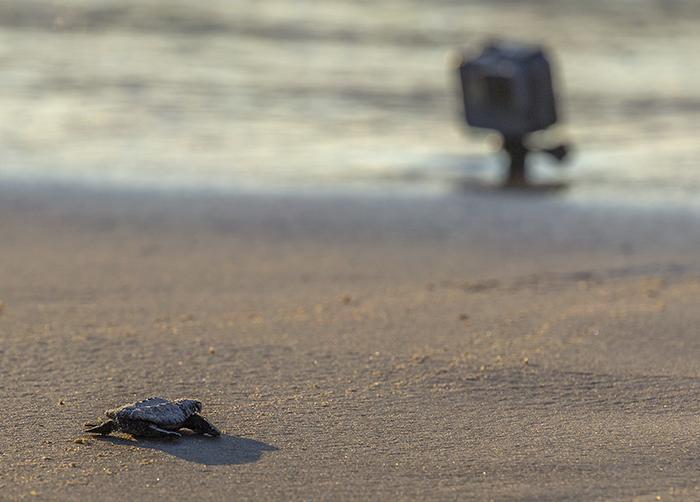
Smaller than an action cam, Padre Island National Seashore / Rebecca Latson

Heading toward the Gulf of Mexico, Padre Island National Seashore / Rebecca Latson
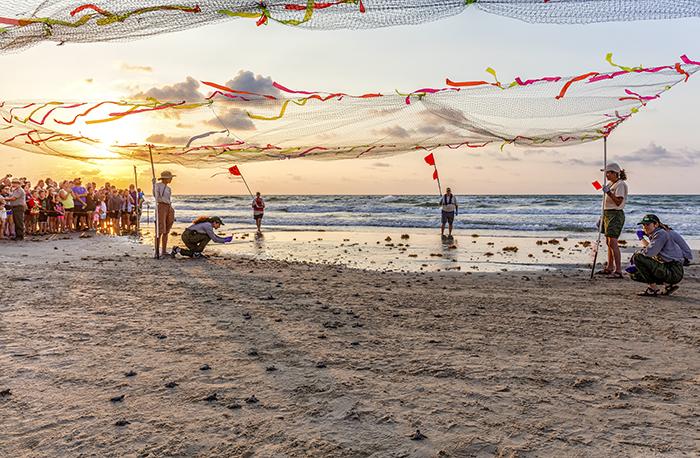
The hatchling release, Padre Island National Seashore / Rebecca Latson

Heading into the water, Padre Island National Seashore / Rebecca Latson

Two more remaining, Padre Island National Seashore / Rebecca Latson
Thanks to Dr. Shaver’s generosity, I was fortunate enough to photograph more than one hatchling release, close-up. I enjoyed the privilege of watching Dr. Shaver, her staff, and Sea Turtle Team volunteers work to educate the visiting public while providing a safe start to a life at sea for these 2-inch-long hatchlings.
After watching the last of these hatchlings struggle across the beach and into the water to the applause of the public, staff, and myself, I arrived at the conclusion that the Kemp’s ridley sea turtle, along with the other four threatened and endangered species found along the Texas coast, are much like frogs or a coal miner’s canary. They signal changes in the health of our environment. The ongoing scientific work performed by Dr. Shaver and the Division of Sea Turtle Science and Discovery will hopefully lead to knowledge helpful not only to increasing this endangered sea turtle’s population, but also to improving our own environment, which, in turn, will improve the Kemp’s ridley’s environment.

Heading toward a new life in the Gulf of Mexico, Padre Island National Seashore / Rebecca Latson





